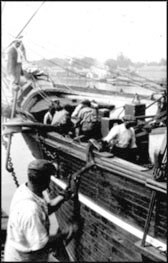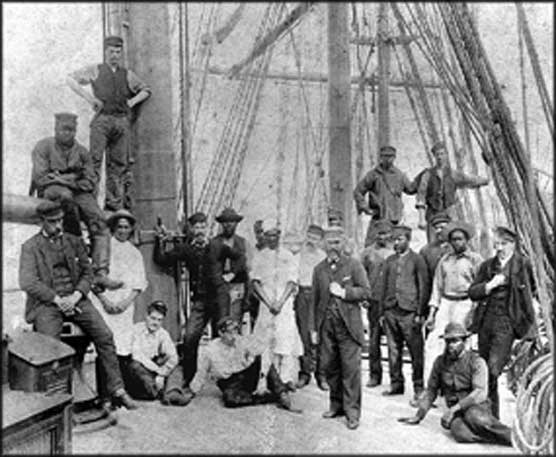
NPS Whaling: Opportunities for African Americans in a Hard BusinessThe whaling industry, centered until the 1870s in New Bedford, employed a large number of African Americans. This was in part due to the Quaker tradition of tolerance in the New Bedford area, but more importantly, to the large demand for manpower in an expanding industry requiring unusually large crews. Some Black seamen in the business were Americans, from the Northeast and the South, some were from the West Indies, and a significant group was from the Cape Verde Islands off the African coast. Whatever their origin, Black seamen found acceptance as hard workers and skilled mariners in an industry that was physically demanding, dirty, and often financially unrewarding. When the center of the industry moved to San Francisco in the 1870s, African Americans continued to form a large percentage of the crews. The whaling business was no doubt the largest employer of African Americans seamen on the West Coast until it ended shortly before World War I. 
SAFR 21374 Captain William T. ShoreyWilliam T. Shorey (1859 - 1919) was a famous captain in the last days of whaling. He was born in Barbados, the son of a Scottish sugar planter and an Indian creole woman. Shorey began seafaring as a teenager and in 1876 he made his first whaling voyage. Whaling brought him to California and he married the daughter from a leading African American family in San Francisco. In 1886 he became the only Black West Coast ship captain. Known for his skill and leadership, Shorey experienced many adventures and dangers at sea with multiracial crews before his retirement in 1908. Over time, larger, steam-powered vessels took the place of obsolete sailing ships and Black seamen were forced to accept inferior employment on ships as cooks and stewards. The era of significant participation by Black seamen in whaling ended in 1923 when the Wanderer went aground off Nantucket, MA. 
NPS SAFR K9.28,157nl Black Men in Foreign Flag Sailing ShipsBlack men were often found among the crews of British ships, and even some German and Scandinavian ships, calling at West Coast ports. Black faces appear in about one quarter of all the foreign flag crew photographs in the park's collections. In many cases the men are clearly cooks or stewards, but in a number of photos the men are clearly seamen living and working on terms of complete equality with other members of the crew. The majority of Black seamen in British ships were probably from the West Indies, but we do not have references for African Americans hired as seamen in foreign ships at New York and other East Coast ports. 
Photograph from "Marinship At War," by Charles Wollenberg African Americans in ShipbuildingShipwrights and other shipyard workers were among the first workers in this country to be unionized. As was often the case, the existence of craft unions meant that African Americans were largely excluded from most major shipyards. The exception to this was in the South. In 1902 at the Newport News shipyard in Virginia, about two thirds of the 5000 employees were African Americans. During the building boom of World War I, African American employment rose rapidly, again mostly in the South. By 1919 there were 24,500 African American shipyard workers in the country, about 20% in skilled trades. During the period between the wars shipbuilding virtually ceased, throwing most shipyard employees out of work. On the West Coast, the great shipbuilding program of World War II brought tremendous opportunities for African Americans in the industry. Prior to the war, African Americans comprised no more than 3%, or 1,800 workers, out of a workforce of approximately 60,000. By 1945, there were more than 700,000 workers in western yards, and about 7%, or 50,000, were African American men and women. In the Bay Area, the total African American population rose from less than 20,000 in 1940 to over 60,000 in 1945. Shipbuilding jobs were the primary factor in this migration which has been called "...the most important event in the history of African Americans in the Bay Area." 
USCG The Navy: A Mixed LegacyThroughout most of its history, the Navy has followed a policy of employing Black Americans in all enlisted grades. They were active in both naval and privateer crews during the Revolutionary War. A brief period of discrimination ended with the War of 1812. From then until 1915, Black Americans served in the ranks of all naval vessels. During the Civil War, at least six Black Americans were awarded the Congressional Medal of Honor. Only officer ranks were closed to them during this period. In 1915, an executive order from President Wilson ordered segregation for all branches in the military. Until 1942, Black Americans were recruited only as messmen. Throughout World War II, opportunities for Black Americans gradually expanded and the first twelve Black officers were commissioned in 1944. In 1946, a Navy order finally ended official segregation throughout the Navy. Desegregation in practice took longer to achieve, but while progress was slow, it was significant. Although the Navy had no commissioned Black officers in the 19th century, this restriction did not hold for the Revenue Service, the predecessor of the modern Coast Guard. Captain Healy, a Black American, rose to the rank of Captain in 1883. From 1886 until 1895 Healy commanded the Bear, a steam barkentine, on patrols in the North Pacific, Bering Sea, and Arctic Ocean. The Bear was virtually the only law in these Northern regions, enforcing quotas in the sealing industry, protecting native people from exploitation, and keeping the peace among white settlers. She performed many feats of heroic rescue among the whaling fleet and the isolated outposts of trappers and hunters. Captain Healy was known as a stern disciplinarian, and was accused of brutalizing his seamen on at least one occasion. Although formally exonerated from these charges, it is no doubt true that he was a hard man, performing a difficult and demanding duty. |
Last updated: December 8, 2025
